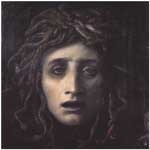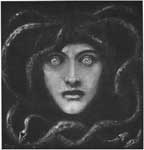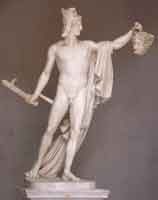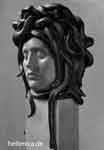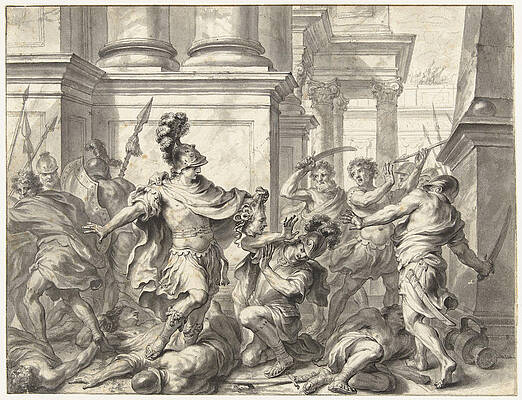.
And to Phorkys Keto bore the Graiai .. and the Gorgones who, beyond the famous stream of Okeanos, live in the utmost place toward night, by the singing Hesperides: they are Sthenno (Strong one), Euryale (Wide-Stepping), and Medousa (The Guardian), whose fate is a sad one, for she (Medousa) was mortal, but the other two immortal and ageless both alike... But when Perseus had cut off the head of Medousa there sprang from her blood great Khrysaor and the horse Pegasos so named from the springs (pegai) of Okeanos, where she was born... Hesiod Theogony
In Greek mythology, Medusa (Μέδουσα "The Guardian"), was the only mortal of the three Gorgon sisters.
The gorgons, Medusa, Stheno, and Euryale, were female monsters with brass hands, sharp fangs and hair of living, venomous serpents. Every creature who looked directly at Medusa was turned to stone.
Medusa and her other sisters the Graeae were daughters of Phorcys and Ceto. Medusa was a beautiful maiden raped by Poseidon in Athena's temple. Poseidon was an arch-rival of Athena's since he vied for dominance over Athens; Athena offering the olive tree, Poseidon, the horse. Athena changed Medusa into a Gorgon as punishment for desecrating her temple. She turned Medusa's hair into snakes, her face hideous and banished her beyond the Hyperborean lands.
While Medusa was with child by Poseidon, she was killed by Perseus with help from Athena and Hermes. Perseus used Medusa's head to petrify Atlas, rescue Andromeda, and kill Polydectes. Then he gave it to Athena, who placed it on her shield Aegis.
From Medusa's blood came two offspring by Poseidon: Pegasus and Chrysaor.
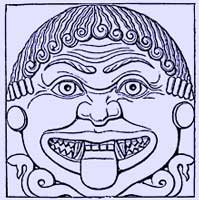
Archaic Medusa
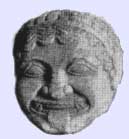
Medusa image from Athens, discovered December 1888 SW of the Parthenon. Hair, lips and tongue with red color traces. Acropolis Museum Inv 701
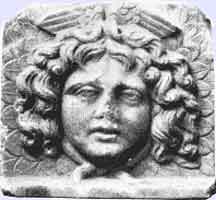
Medusa Athens National Museum
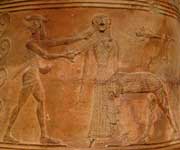
The archaic Artemis Temple with one of the earliest Pediment figures. The problem of covering a triangular shape with figures solved by a primitive method.
The Artemis Temple and Medusa in Corfu

Who meet its ghastly stare are turned to stone,
Like those who saw Medusa.
Mephistopheles in Goethe's Faust.
I have a head of Zeus next to my bed which I use to pray each morning said Goethe (1749-1832), the German poet and author of Faust, but Goethe (“Every one should be Greek in his own manner. But he should be Greek”, Antik und Modern, 1818) had also a copy of the Rondanini Medusa which he obtained from the King Ludwig in 1826. This Medusa is so different than the bizarre archaic Medusa of the Corfu Artemis Temple.
Asteroid 149 Medusa, and an important geological region on the planet Mars, Medusa Fossae bear her name.

Medusa Coin from Neapolis (Thrace, colony of Thasos , Kavala today) (Greek Wikipedia)
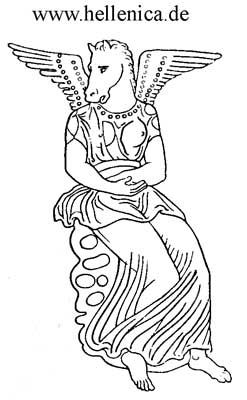
Medusa with a Pegasus head, from a Vase now in Naples, probably a symbol of the birth of Pegasus
Medusa, Caravaggio
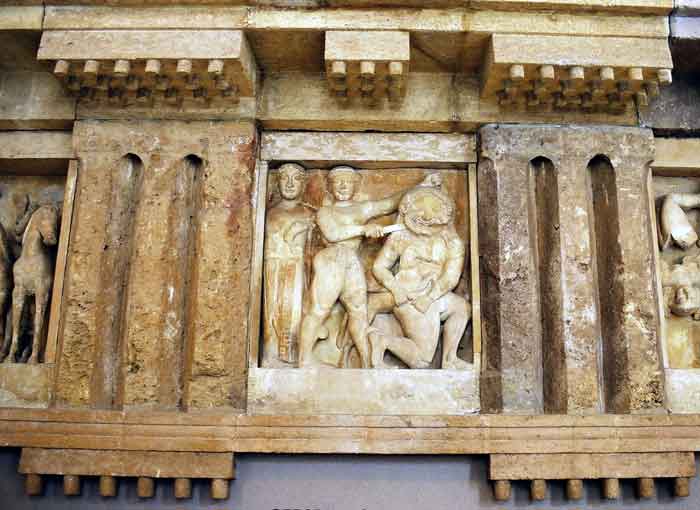
Athena, Perseus and Medusa , Metopes of the C Temple of Selinunte (Source), Museo Regionale Archeologico, Palermo
In Film
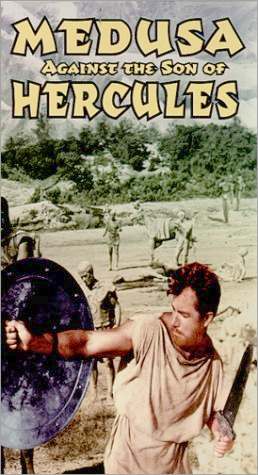

One of many films with Medusa: Medusa against the son of Hercules with some figures transformed into stone, and Clash of the Titans , Perseus on Pegasos with the head of Medusa
Medusa and Perseus, Trauma and Felt Sense in Mythology by John Chitty
Medusa = Traumatic events
The snakes= Reptilian response = core registration of event
Turning people into stone = Immobilization/freezing
Perseus= Heroic warrior = Noble self seeking harmony & order
Shield= the physical body = divine gift for defeating trauma
Looking at Medusa through the reflection of the shield= Developing the “felt sense”
Reflecting Medusa into itself = Slaying the trauma demon with its own process
Pegasus= Flight to freedom = Successful resolution, Resources
Chrysaor= Warrior with the Golden Sword= Clarity & Copability= “Resources”
John Chitty, New Insights into Trauma Therapy
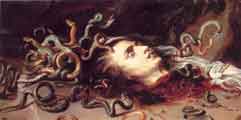
Head of Medusa, Peter Paul Rubens c. 1618 |
||
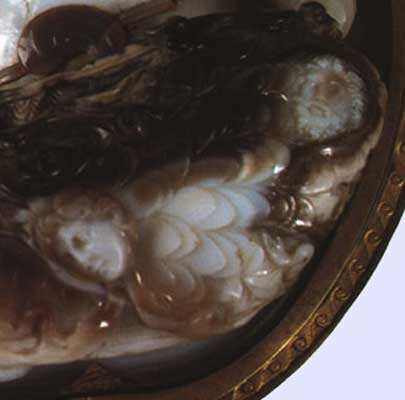

Medusa and Phobos from the The Gonzaga Cameo
Perseus with Minerva Discovering the Sleeping Medusa, Attributed to Andries Cornelis Lens
Perseus shows the head of Medusa, Godfried Maes
Sleeping Medusa, Fernand Khnopff
On The Medusa of Leonardo da Vinci by Percy Bysshe Shelley
M. GARBER, The Medusa Reader, Routledge; 2003, ISBN: 0415900999
Stephen R. Wilk Medusa : Solving the Mystery of the Gorgon, Oxford University Press, 2000, ISBN: 0195124316
See also : Greek Mythology. Paintings, Drawings
| Ancient Greece
Science, Technology , Medicine , Warfare, , Biographies , Life , Cities/Places/Maps , Arts , Literature , Philosophy ,Olympics, Mythology , History , Images Medieval Greece / Byzantine Empire Science, Technology, Arts, , Warfare , Literature, Biographies, Icons, History Modern Greece Cities, Islands, Regions, Fauna/Flora ,Biographies , History , Warfare, Science/Technology, Literature, Music , Arts , Film/Actors , Sport , Fashion --- |
Retrieved from "http://en.wikipedia.org"
All text is available under the terms of the GNU Free Documentation License


